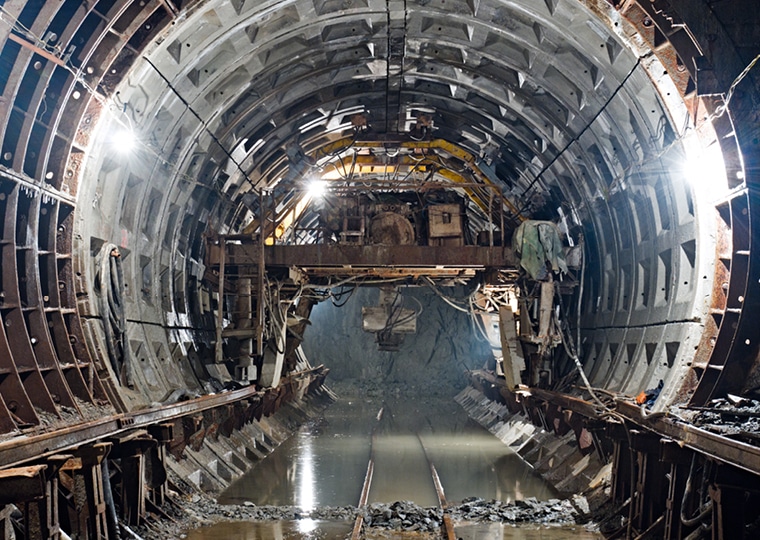
With more government agencies pledging to achieve net-zero emissions by 2050, those of us serving the infrastructure sector are being challenged to develop holistic, data-driven solutions that aim to eliminate carbon emissions across various stages of a project’s lifecycle.
As part of this global initiative, one of the key discussion areas with our clients is around embodied carbon reduction. Embodied carbon is defined as the greenhouse gas emissions associated with the whole life cycle of materials used to create a building or infrastructure project, from the material extraction process through their end-of-life. Advocacy for the elimination of embodied carbon has increased exponentially over the past few years, with organizations like the World Green Building Council and the Structural Engineering Institute making it a centerpiece of their sustainability efforts. And for good reason. As cited by Architecture 2030, a nonprofit that advocates for carbon reduction strategies in design and construction across the globe, we are currently in the midst of the largest wave of urban growth in human history. To accommodate that growth, the organization states that about 2.4 trillion square feet of new floor area will be added to the global building stock – the equivalent of adding an entire New York City to the world every month, for 40 years.
The breakdown of embodied carbon can vary wildly from project to project based on size and material selection. But we do know that approximately half of emissions emanate from the building’s structure, most notably its steel and concrete. Most of concrete’s embodied carbon footprint comes from cement; while cement makes up only 12% of the material’s overall weight, it is responsible for nearly 95% of concrete’s carbon emissions. Cement produces nearly four billion tons of carbon emissions per year and accounts for 5-8% of global emissions.
From a public policy perspective, over the past year, the passage of the federal Inflation Reduction Act and the Biden-Harris Administration’s Federal Buy Clean Initiative both demonstrate that the reduction and ultimate elimination of embodied carbon is a long-term priority. At the state level, we’ve also seen new policies within the last few years geared toward eliminating embodied carbon in California, Oregon, and Washington. At the local level, New York City Mayor Eric Adams signed the Clean Construction Executive Order 23 in 2022, which requires the city’s capital project agencies to commit to actions that will lower embodied carbon starting later this fall.
Due to the urgency of this initiative, STV’s team of sustainability experts have been working closely with our client base to help them navigate new and evolving policies so that buildings and infrastructure under construction can meet these ambitious goals and go beyond. During a recent presentation to a New York City public agency, we walked through a range of key embodied carbon concepts, data, and strategies to inform best practices for addressing Executive Order 23.
One of those strategies involves submitting Environmental Product Declarations (EPDs) for construction projects. One useful analogy often used by embodied carbon experts is to think of an EPD like the nutritional label of a product – but rather than listing calories or saturated fat, it communicates critical environmental information, notably Global Warming Potential (GWP), of construction materials like concrete and structural steel. Continued transparency and coordination between manufacturers, governments, stakeholders, and design firms is necessary to address some of the current challenges with EPDs; they can be expensive to verify and publish externally, especially for smaller manufacturers; Product Category Rules, which guide EPD development, may not be updated fast enough; and the current data needed to create EPDs is sometimes unavailable or inconsistent in how it gets calculated.
More broadly, STV’s sustainability specialists are working with agencies on developing long-term “roadmaps” for embodied carbon reduction. In these circumstances, that means providing guidance for the development of Embodied Carbon Action Plans (ECAPs), a key mandate of Executive Order 23. An ECAP is created by an individual firm or agency to outline how they can improve or change current practices to reduce, and ultimately eliminate, embodied carbon emissions.
Our team is finding that there are various ways to shape an ECAP for your firm; what’s most critical is identifying realistic, actionable steps to achieve the expectations set by policymakers. When we collaborate with an organization, we encourage them to capture what makes their practice and work unique in their ECAP. From there, they can set goals and targets for reduction, identify pilot projects for analysis, and explore launching initiatives like a decarbonization task force to continue momentum and accountability.
Ultimately, we understand that design and construction efforts are nuanced and vary for each client. Implementation of strategies early on in the design process, like requesting materials with lower global warming potential (GWP) values relative to functionally equivalent products during the design specification stage, will allow our clients to meet the evolving goal of reducing embodied carbon, and facilitate the stewardship of a more sustainable and resilient built environment.

Lauren Alger, P.E., ENV SP, is STV’s director of sustainable design within the firm’s Centers of Excellence team. She has experience providing engineering services for several LEED-certified and Institute for Sustainable Infrastructure award-winning projects.

Meghan Timmons, ENV SP, is a sustainability planner within STV’s Centers of Excellence. She researches, strategizes, and communicates sustainable design solutions specific to transportation infrastructure and the built environment.







